Clinical Frailty Scale and Charlson Comorbidity Index as predictors of hospitalization and mortality risk after kidney transplant failure
IF 2
4区 医学
Q2 UROLOGY & NEPHROLOGY
引用次数: 0
Abstract
Introduction and objectives
Kidney transplant (KT) recipients who experience graft failure and return to dialysis face a higher risk of adverse outcomes. This study aimed to identify risk factors for hospitalization and mortality two years post-graft failure.
Materials and methods
We conducted a retrospective cohort study of end-stage kidney disease patients who initiated hemodialysis following graft failure between January 2019 and December 2020. The Clinical Frailty Scale (CFS) and the Charlson Comorbidity Index (CCI) were assessed for each patient at the time of graft loss. The primary outcomes were hospitalization and all-cause mortality over a two-year follow-up period.
Results
A total of 107 patients were included, with a mean age of 55.9 years and a mean graft survival of 134 months. The two-year hospitalization rate was 37.4%, with lower residual diuresis and higher CFS identified as independent risk factors. The two-year mortality rate was 16.8%. A multivariate regression model, explaining 82% of the variance, confirmed that higher CCI, higher CFS, and lower residual diuresis significantly increased mortality risk. A CCI cut-off of ≥8 (AUC 0.95) further stratified patients at elevated mortality risk. Immunological and transplant-related variables did not influence mortality or hospitalization risk.
Conclusions
In this cohort, frailty defined by CFS was associated with hospitalization and mortality, while comorbidity burden evaluated by CCI was strongly related to mortality. These tools may help personalize the care of patients with a failing graft.
临床虚弱量表和Charlson合并症指数作为肾移植失败后住院和死亡风险的预测因子
肾移植(KT)受者经历移植物衰竭并返回透析面临更高的不良后果风险。本研究旨在确定移植失败后两年住院和死亡的危险因素。材料和方法我们对2019年1月至2020年12月期间因移植物失败而开始血液透析的终末期肾病患者进行了回顾性队列研究。临床虚弱量表(CFS)和Charlson合并症指数(CCI)评估每个患者在移植物丢失时的情况。主要结局是住院治疗和两年随访期间的全因死亡率。结果共纳入107例患者,平均年龄55.9岁,平均移植存活期134个月。2年住院率为37.4%,剩余利尿较低和CFS较高为独立危险因素。两年死亡率为16.8%。多变量回归模型解释了82%的方差,证实了较高的CCI、较高的CFS和较低的残余利尿显著增加了死亡风险。CCI临界值≥8 (AUC 0.95)进一步将死亡风险升高的患者分层。免疫和移植相关变量不影响死亡率或住院风险。结论在该队列中,CFS定义的虚弱与住院和死亡率相关,而CCI评估的合并症负担与死亡率密切相关。这些工具可能有助于对移植失败的患者进行个性化护理。
本文章由计算机程序翻译,如有差异,请以英文原文为准。
求助全文
约1分钟内获得全文
求助全文
来源期刊

Nefrologia
医学-泌尿学与肾脏学
CiteScore
3.40
自引率
7.70%
发文量
148
审稿时长
47 days
期刊介绍:
Nefrología is the official publication of the Spanish Society of Nephrology. The Journal publishes articles on basic or clinical research relating to nephrology, arterial hypertension, dialysis and kidney transplants. It is governed by the peer review system and all original papers are subject to internal assessment and external reviews. The journal accepts submissions of articles in English and in Spanish languages.
 求助内容:
求助内容: 应助结果提醒方式:
应助结果提醒方式:


